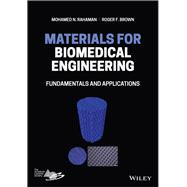A comprehensive yet accessible introductory textbook designed for one-semester courses in biomaterials
Biomaterials are used throughout the biomedical industry in a range of applications, from cardiovascular devices and medical and dental implants to regenerative medicine, tissue engineering, drug delivery, and cancer treatment. Materials for Biomedical Engineering: Fundamentals and Applications provides an up-to-date introduction to biomaterials, their interaction with cells and tissues, and their use in both conventional and emerging areas of biomedicine.
Requiring no previous background in the subject, this student-friendly textbook covers the basic concepts and principles of materials science, the classes of materials used as biomaterials, the degradation of biomaterials in the biological environment, biocompatibility phenomena, and the major applications of biomaterials in medicine and dentistry. Throughout the text, easy-to-digest chapters address key topics such as the atomic structure, bonding, and properties of biomaterials, natural and synthetic polymers, immune responses to biomaterials, implant-associated infections, biomaterials in hard and soft tissue repair, tissue engineering and drug delivery, and more.
- Offers accessible chapters with clear explanatory text, tables and figures, and high-quality illustrations
- Describes how the fundamentals of biomaterials are applied in a variety of biomedical applications
- Features a thorough overview of the history, properties, and applications of biomaterials
- Includes numerous homework, review, and examination problems, full references, and further reading suggestions
Materials for Biomedical Engineering: Fundamentals and Applications is an excellent textbook for advanced undergraduate and graduate students in biomedical materials science courses, and a valuable resource for medical and dental students as well as students with science and engineering backgrounds with interest in biomaterials.








